October 28, 2008 — Have you heard the one about the two men looking to launch a probe to Pluto who went to Burger King to find a part for their spacecraft?
It might sound funny, but it's no joke.
To understand how a fast food restaurant almost factored into NASA's first mission to the last planet, you need to know a bit of the history behind New Horizons, which just recently marked 1000 days on its nine year flight to Pluto.
"New Horizons was a nuclear launch," explained Dr. Alan Stern, New Horizons' Principal Investigator, of his probe's plutonium-powered battery. "Those are rare. There are a lot of preparations for safety's sake but they also require all major stakeholders being briefed and in agreement we are ready to go."
"After the federal government had given its approval, the state of Florida had to give its approval, so then-Kennedy Space Center director, whose name is Jim Kennedy, and I drove up to Tallahassee one day to see Governor Bush, who was then-governor," recalled Stern of his road trip on November 22, 2005.
Stern described what happened next in an interview with collectSPACE.
"On the way to see the governor -- it was a long drive, I think it may have been three to four hundred miles -- we got to talking about what we might do to get him a little more personally interested in the mission, other than just invite him to the launch," said Stern. "We came upon the thought, why don't we fly a state quarter of Florida?"
As Stern reasoned, they would launch from Florida, some of the parts of New Horizons had been built there and the state quarter just happened to have a space theme. They both liked the idea a lot but upon searching their pockets, came up empty for a quarter to illustrate their point to the governor.
So, at a small town in the panhandle of Florida, they went to a Burger King.
"We tried to find a state quarter in their cash registers. We had their entire staff looking," Stern shared. "It was a pretty surreal scene. The entire time I was thinking, 'Here are these 18- and 19-year-old, minimum wage folks rifling for a quarter that's going to fly to the Kuiper belt."
Not that the restaurant's employees knew of the reason behind their search. "Jim and I sat there and said, 'Should we tell them?' And I was like, 'Nah, it's too involved. They wouldn't believe it if we told them.' We were just a couple of guys with a coat and tie on, stopped in a van."
Unfortunately, despite their best efforts, the Burger King didn't have a Florida state quarter to offer them and as they didn't have the time to stop at every other fast food joint along the way, Stern and Kennedy almost forewent flying the quarter.
"Toward the end of the briefing, I mentioned to [Governor Bush] that we really wanted to fly a Florida state quarter but couldn't come up with one and it was due to our poor planning because we had only thought of it today," Stern recounted. "And he said, 'Well, I've got plenty!'" and with that ran out of the room and when he came back, he had a roll of the quarters. "He said, 'Fly these!'"
Stern accepted the roll from the governor, but explained he could only fly one. The others would be distributed to team members as a souvenir of the mission.
Less you think however, that the quarter flew simply as a gesture to the governor, it served a bonafide purpose on the spacecraft.
"For spin balance, we need to add a number of kilograms to various places [on New Horizons]," explained Stern. "We knew this was the case because the moments of inertia of the spacecraft and the dynamical properties of it, that we would have to trim it out down to literally the grams-level with balance weights. Of course, we had a whole variety of big ones and little ones; you start off with adding a kilogram here and a kilogram there and you end up getting smaller and smaller weights in various places until you're done. We used the coins to that purpose," he said.
"Since we needed a counter balance to [the Florida state quarter], we decided to fly a second state quarter. We picked Maryland because that is where the spacecraft was built. And because we had so many people back in Maryland at the Applied Physics Lab and at Goddard, it was easy for someone to ship us a quarter really quick."
Keeping focused on the mission
After flying by Pluto and its moon Charon in 2015 and then encountering Kuiper belt objects between 2016 and 2020, New Horizons will become only the fifth probe to leave the solar system.
The first four, Pioneers 10 and 11 and Voyagers 1 and 2, all carried messages that identified their origin -- Earth -- should they be found someday by future space explorers.
The Pioneers carried plaques depicting the nude figures of a man and a woman as well as symbols representing the location of Earth. Attached to the Voyagers were gold plated records that contained imagery and sounds meant to convey humankind's story.
Two quarters somewhat pale in comparison.
New Horizons has a pair of United States flags on-board in recognition of its mission to complete the grand survey of the planets, as well as a couple of compact discs with the submitted names of 434,000 people and the photos of team members, but neither are intended as messages to future spacecraft salvagers.
"We don't have such a message on-board, [although] we did discuss it" Stern explained.
"When the Pioneer plaques were created, they ended up creating some controversy: they offended some people's sensibilities dating back to the 70s having to do with the drawings of unclothed human beings, even sanitized as they were. And when the Voyager put plaques on-board, they went through a huge exercise as a result to vette the content," he continued.
"All that is preface to, of course, is in the 90s there were many attempts to get a Pluto mission and and every one of them came crashing down. When we won New Horizons, I was determined to make sure we actually got this one out of the viewgraph stage and actually to flight," stated Stern.
"After we got into the project in 2002, it was suggested we add a plaque and I rejected that simply as a matter of focus. We had a small team on a tight budget and I knew it would be a big distraction. I didn't want to see us being distracted from the project and find ourselves derailing the project or getting into flight and finding we had some problem and wishing we'd have been more focused during development."
Not everyone agreed with Stern's decision.
"One individual on my team, one scientist, felt strongly we should have a plaque and protested that to NASA Headquarters, but NASA Headquarters agreed with me that we were taking the best course of action. We put that issue issue to bed in early 2003," said Stern.
Flying with pioneers
Stern was not entirely opposed however to including a few symbolic items on the spacecraft, including two that paid tribute to past and future pioneers.
"It started because we wanted to do some things for education and public outreach. That included for example, flying the CD-ROM with people's names on it," he said. "[Those were] more efforts of the heart than the head, the rest of the spacecraft being, of course, of the head. And then some other opportunities came about."
One of those other opportunities was a chance to honor the wishes of Pluto's discoverer, Clyde Tombaugh, who died on January 17, 1997, two days and nine years prior to New Horizon's launch.
"In the mid-1990s, I chaired a group that was called the Outer Planets Working Group and [it] was at the heart of Pluto mission planning at the time. I worked very heavily with a Jet Propulsion Laboratory crew that Rob Staehle led. Rob and I had learned from Clyde, who was still living that he would very much like it if his ashes would fly."
"Rob actually worked out an arrangement after Clyde had passed in 1997 for that to happen on the Pluto Kuiper Express mission," Stern said.
Unfortunately, that mission ran into cost overruns and the flight was canceled, but having known of the arrangement and with Staehle's blessing, Stern contacted Tombaugh's family to offer flying the ashes on New Horizons.
"When the time came, they sent about an ounce of Prof. Tombaugh's ashes directly to me and I carried them to be placed on the spacecraft in a container," Stern recalled. "It was very personal."
If the inclusion of Tombaugh's cremains represented the mission's destination, another artifact on-board sought to underscore the project's trailblazing nature.
"It is such a landmark spacecraft," described Stern, not of his own Pluto-bound probe but of the 2004 Ansari X Prize winner SpaceShipOne. A small segment of the first privately-funded crewed spacecraft is flying aboard New Horizons as a salute to the way it is "opening up space in a completely different way to individuals" and that it was a "uniquely American achievement".
"I think those are both parallels to New Horizons," Stern reflected. "I had been on a trip to visit [SpaceShipOne designer] Burt Rutan for a different reason and asked him if we could have a piece."
"I agreed with him on the words for a little plaque, just as we did with Tombaugh."
Not yet explored
In total, there were nine mementos chosen to fly on New Horizons.
"Why nine mementos? I bet you can guess," said Stern while announcing all nine during a recent dedication of the spacecraft's replica now hanging in the Smithsonian.
The ninth was a 1991 U.S. Postal Service stamp issued as part of a set celebrating the exploration of the planets. Under a depiction of Pluto, the stamp was inscribed "Not yet explored".
"Pluto may not have been explored when that stamp set came out, but we were going to conquer that," Stern said.
"I wanted to fly it as a sort of 'in your face' thing." |
|
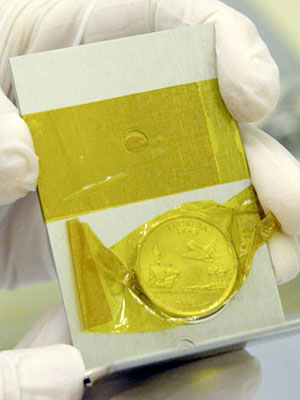
A Florida quarter, just before being put on New Horizons. (NASA)
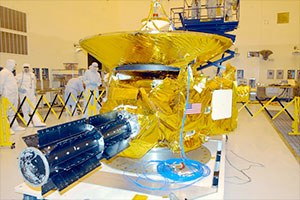
New Horizons before launch in 2006. (LaunchPhotography.com)
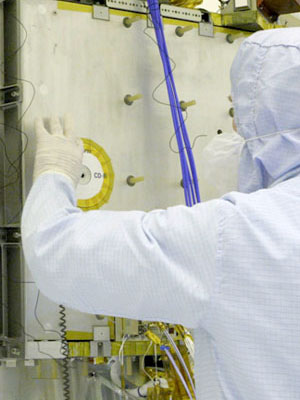
Technicians affix a CD containing 434,738 names. (NASA)
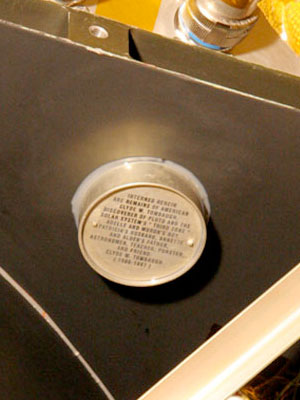
A small container of Clyde Tombaugh's ashes is affixed to the inside, upper deck of the spacecraft, with the inscription: "Interned herein are remains of American Clyde W. Tombaugh, discoverer of Pluto and the solar system's 'third zone' Adelle and Muron's boy, Patricia's husband, Annette and Alden's father, astronomer, teacher, punster, and friend: Clyde Tombaugh, 1906-1997." (NASA)
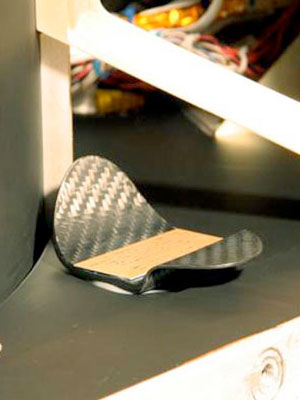
A piece of SpaceShipOne is installed on New Horizons with a two-sided inscription. Front: "To commemorate its historic role in the advancement of spaceflight, this piece of SpaceShipOne is being flown on another historic spacecraft: New Horizons. New Horizons is Earth's first mission to Pluto, the farthest known planet in our solar system." Back: "SpaceShipOne was Earth's first privately funded manned spacecraft. SpaceShipOne flew from the United States of America in 2004." (NASA)
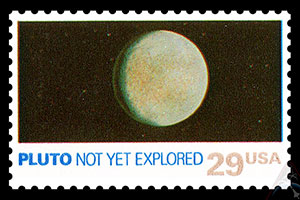
A 1991 U.S. postage stamp flying aboard NASA's New Horizons probe to Pluto is soon to be outdated given its inscription labeling the dwarf planet as 'Not Yet Explored.' |
